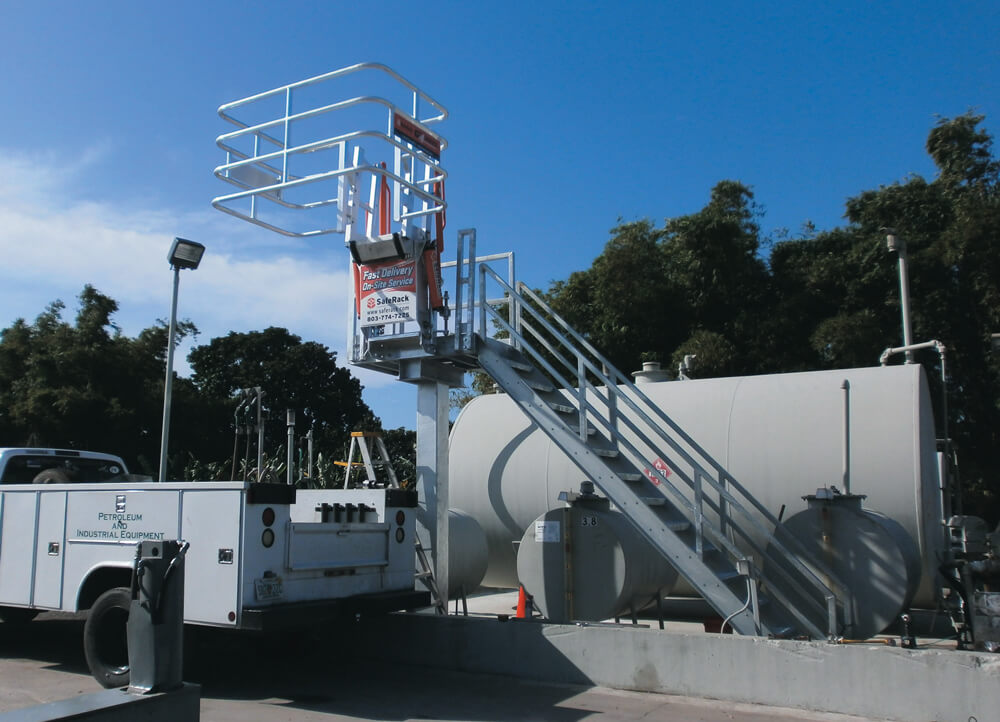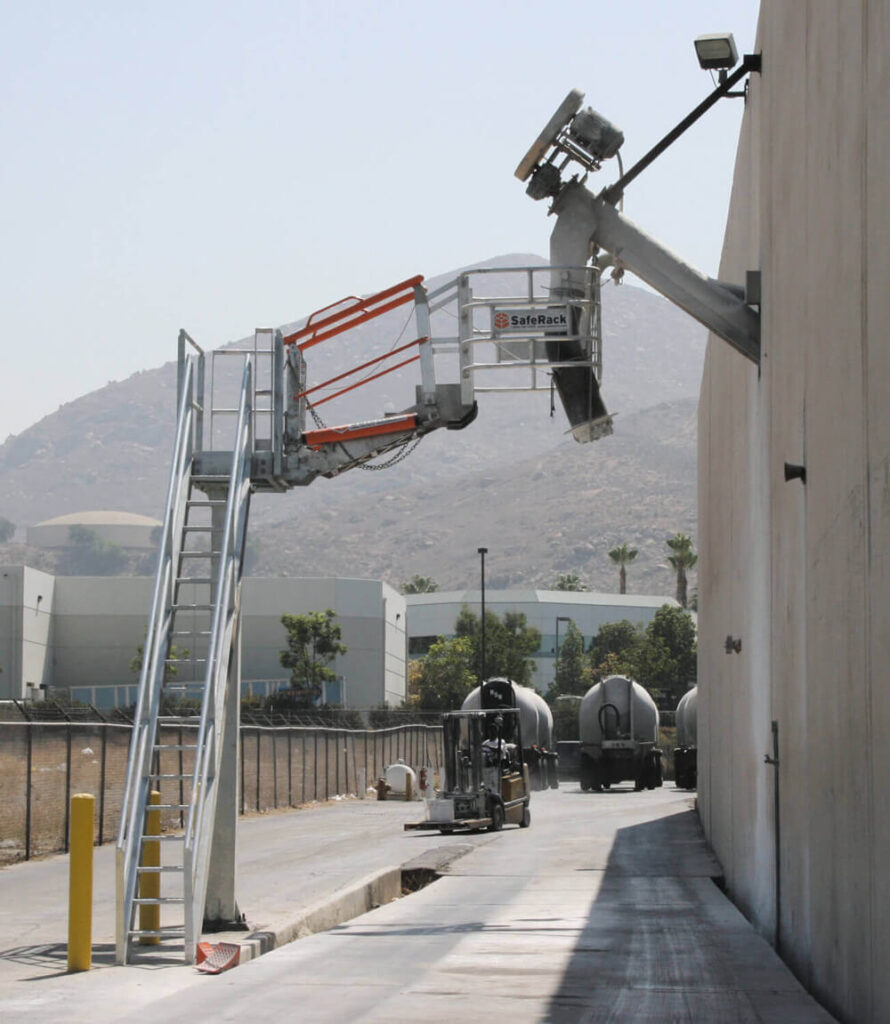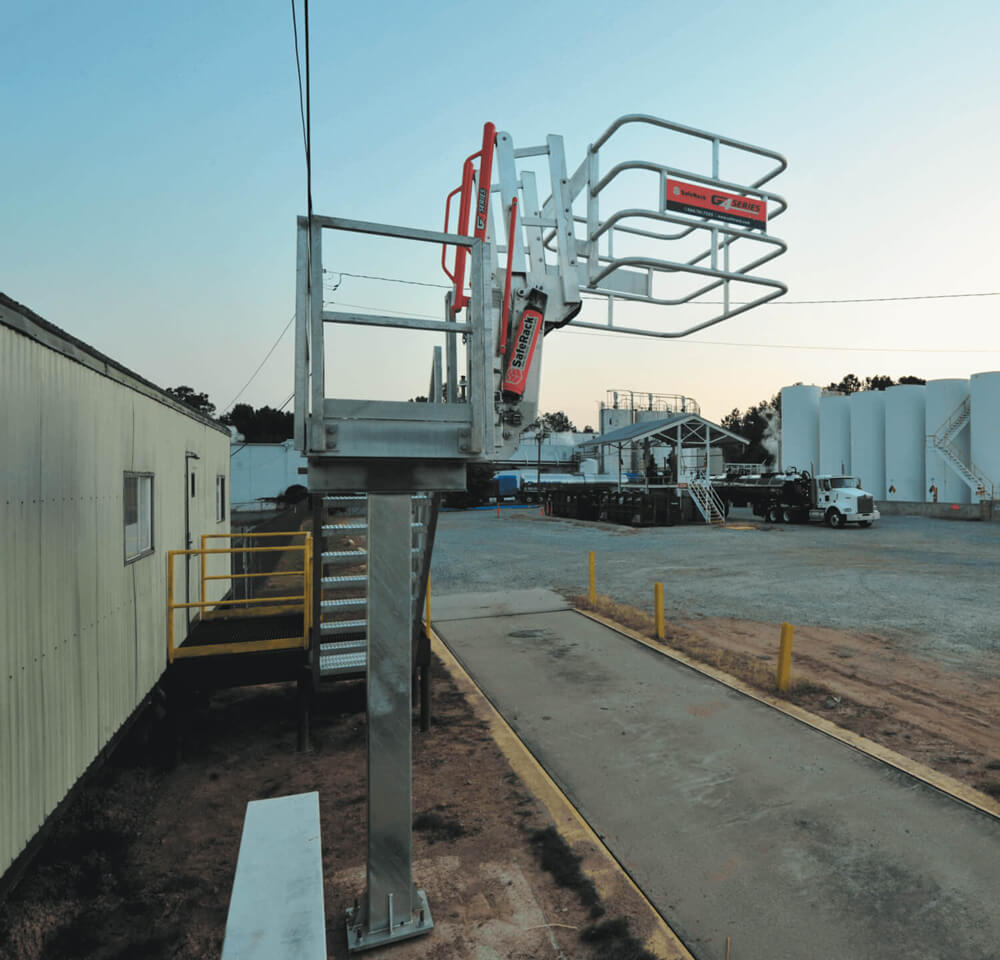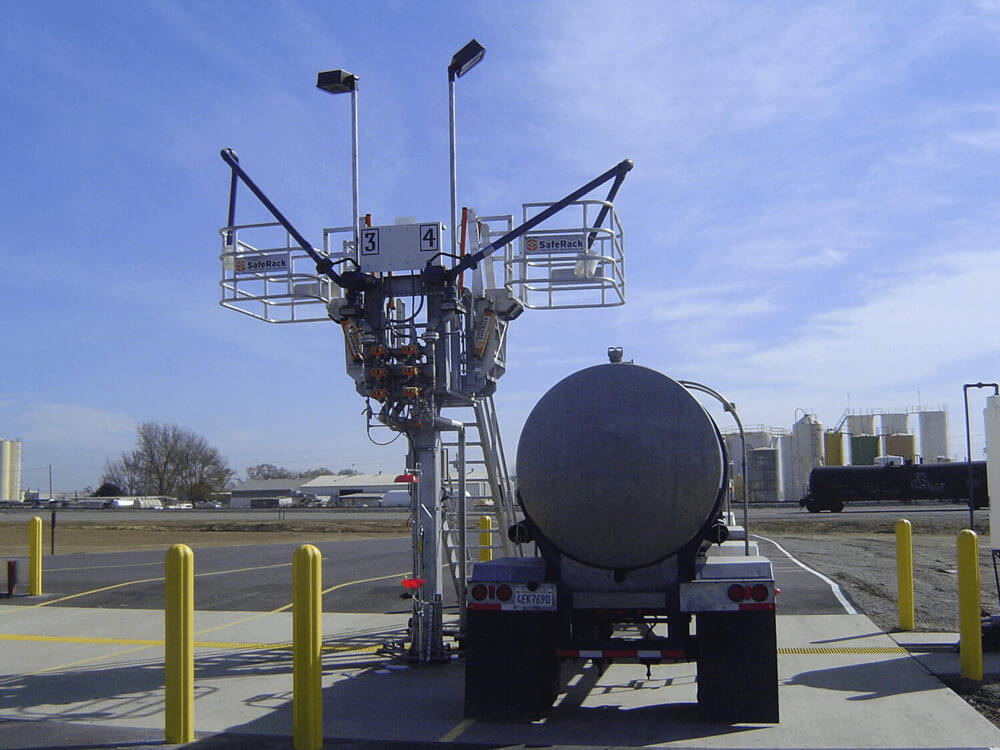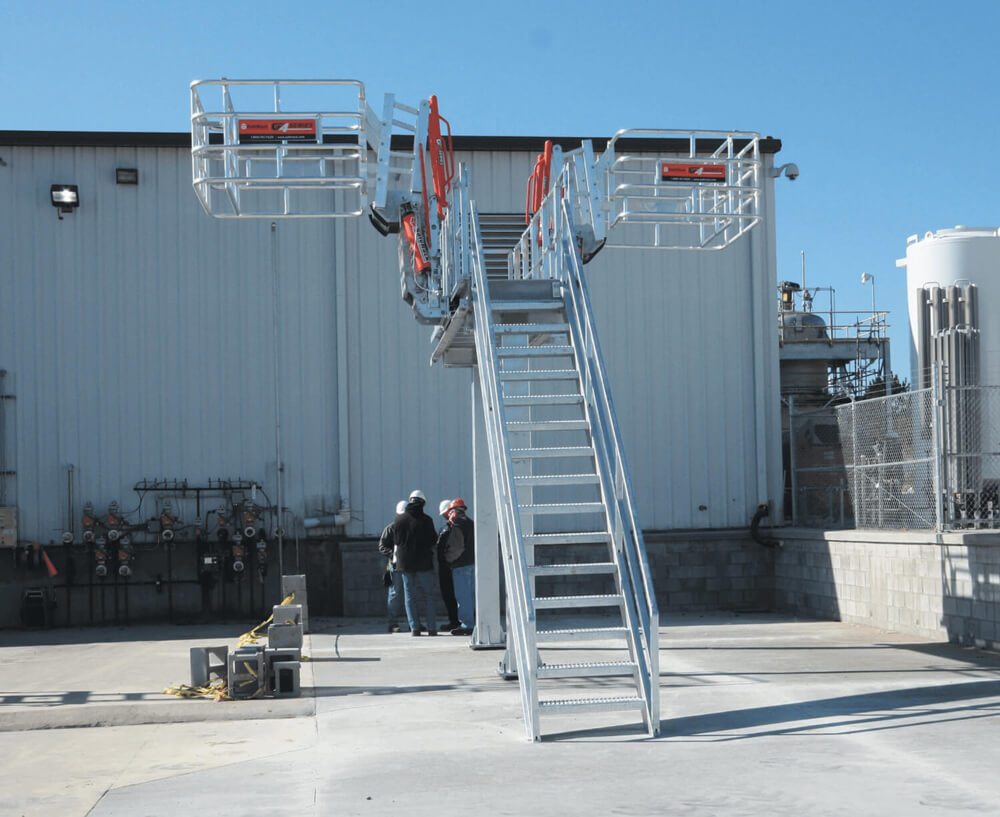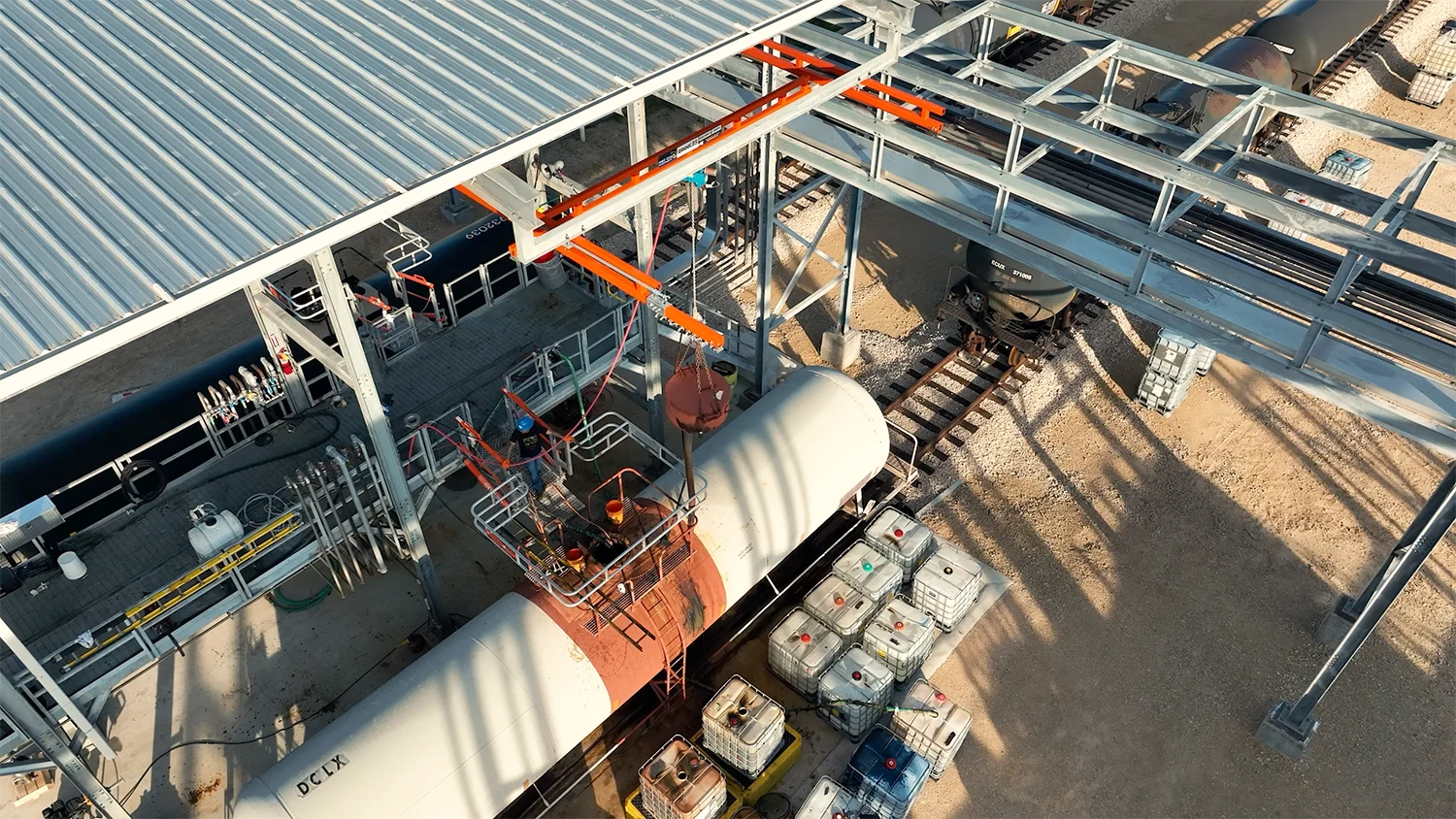
Black Liquor
Safe & Efficient Specialized Loading & Fall Protection Solutions
Black Liquor Handling Design, Loading, and Installation
SafeRack provides custom black liquor handling equipment, including loading and fall protection solutions for railcars and tank trucks, ensuring compliance with safety regulations while improving operational efficiency. Our black liquor loading systems incorporate closed-loop loading arms, spill containment solutions, and safety measures that protect workers and minimize environmental risks.
- Fall Protection – SafeRack’s OSHA-compliant gangways and safety cages provide secure access for black liquor railcar loading platforms and black liquor truck loading systems during top-loading operations.
- PPE Compliance – Handling black liquor requires gloves, chemical-resistant clothing, and proper eye protection to prevent exposure to its highly caustic nature.
- Closed-Loop Loading – Black liquor transfer pumps and piping with vapor recovery systems reduce exposure to toxic fumes and improve worker safety.
- Emergency Response – Facilities handling black liquor in paper mills must implement immediate decontamination protocols and provide first aid stations to address exposure incidents.

Black Liquor
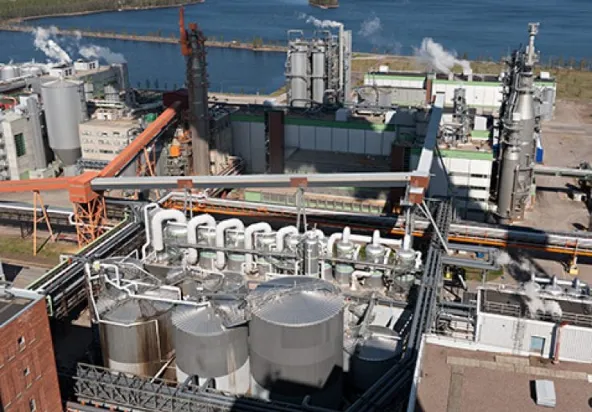
Enhancing Workplace Safety with Reliable, Compliant Access Systems
What is Black Liquor?
Black liquor is a by-product of the pulp and paper industry, created during the Kraft pulping process. Composed of lignin residues, cellulose, and other organic compounds, it is highly caustic and presents significant safety risks, including severe burns, eye damage, and respiratory harm if mishandled. Black liquor soap, a derivative of black liquor, is separated and further processed into valuable by-products.
Chemical Properties & Safety
Black liquor is a by-product of the Kraft pulping process, characterized by its dark brown to black appearance and strong, unpleasant odor. It comprises water-soluble lignin residues, organic substances, and sodium-based chemicals. Primarily, black liquor is utilized in recovery boilers to reclaim pulping chemicals and generate energy; it can also be processed to extract tall oil. Due to its highly caustic nature, black liquor poses significant hazards, including severe burns, lung damage, and the release of toxic gases when mixed with acids or subjected to heat.
Black Liquor 101: Understanding Its Role and Hazards in the Paper and Pulp Industry
Black liquor is a dark, caustic by-product generated during the Kraft pulping process in the paper and pulp industry. It contains water-soluble lignin residues and other organic compounds, including cellulose, along with sodium-based chemicals used in the cooking process. This liquid has a distinctive rotten egg odor due to sulfur compounds and is commonly reclaimed for energy recovery and chemical reuse. In recovery boilers, black liquor is burned to extract energy and recycle inorganic pulping chemicals, supporting both cost efficiency and sustainability within pulp mills. Additionally, valuable by-products such as tall oil can be separated from black liquor during processing.
Despite its usefulness in closed-loop recovery systems, black liquor presents significant hazards. It is highly alkaline and can cause severe skin burns, eye damage, and respiratory injuries upon contact or inhalation. If mists or vapors are inhaled, the damage may extend to the lungs and upper respiratory tract. As a caustic chemical, black liquor can induce coagulative necrosis—a condition where tissue damage continues long after exposure if not promptly treated.
Under certain conditions, especially when heated or combined with incompatible materials, black liquor may release dangerous sulfur gases such as hydrogen sulfide, methyl mercaptan, dimethyl sulfide, and dimethyl disulfide. These compounds are toxic even at low concentrations, and their emission levels can vary depending on the liquor’s strength. Whether classified as strong or weak, all forms of black liquor require strict control measures and environmental monitoring during handling and storage.
To mitigate risks, personnel should avoid contact with acids, oxidizing materials, and reactive metals, all of which can trigger hazardous reactions. Combustible materials should also be kept away, as black liquor may ignite or explode upon contact in the presence of an ignition source.
In the event of exposure, personnel should be moved immediately to fresh air. Contaminated clothing must be removed, and affected skin should be thoroughly washed with soap and water. Eyes should be flushed with tepid water for at least 15 minutes. If ingestion occurs, vomiting should not be induced; emergency medical assistance and poison control should be contacted without delay.
Understanding the chemical risks and safe handling practices associated with black liquor is essential to maintaining workplace safety, minimizing environmental impact, and ensuring regulatory compliance in paper and pulp operations.
Loading & Unloading Procedures for Black Liquor in the Paper Industry
Black liquor is commonly loaded and unloaded using specialized closed-loop systems designed to minimize exposure to vapors and ensure operational safety. In railcar loading, black liquor is top-loaded using 4-inch stainless steel loading arms with a vapor plate and 3-inch vapor return hose, forming a closed-loop system that limits environmental emissions and supports safe handling of black liquor in pulp mills.
Railcars typically used for black liquor transfer include 26,000-gallon DOT-111 insulated tank cars equipped with safety valves. These railcars are approximately 9 feet in outside diameter, with an overall length of 45 to 50 feet, and include either 6-by-6-foot center openings or offset crash box configurations.
To ensure safe and efficient railcar loading and unloading, SafeRack supplies key equipment including GX Gangways with safety cages for fall protection, black liquor spill containment solutions such as track pans and containment berms, and closed-loop vapor recovery systems to support vapor control and ventilation.
For tank truck loading and unloading, DOT-approved trailers such as MC 307 or low-pressure ISO chemical containers are used. These trucks are typically bottom unloaded using remote-controlled stop valves that reduce direct operator contact with the product.
Essential equipment includes pressure relief valves to prevent buildup, grounding systems to mitigate static discharge during transfer, and SafeRack’s track pans and drainage systems to manage and contain any accidental spills. These systems work together to support black liquor safety solutions that protect personnel, the environment, and facility assets across both truck and railcar loading platforms.
Products
Semi Trailer & Truck Steps
Semi-truck steps for loading semi and flatbed trailers
Break Away Smart-Hose Safety System
Smart-Hose™ Break-Away Safety System (LL3-B) can help protect your facility from the potentially devastating consequences associated with pull-away incidents.
Samplers and Oil Thieves
Crude oil samplers, including oil thieves and sample catchers.
Hose and Electric Reels
Our hose and electric reels selection help keep your hose neatly wrapped away when not in use. The hose reels come with ready-to-mount brackets for easy installation.
Gate Openers and Hopper Car Shakers
The PCS-3 Hopper Car and Hopper Trailer Shakers can be modified to comply with force and design requirements set for the ACF “center-flow” hopper car, Contact us for details.
Guardrail Systems
Guardrail Systems from SafeRack, the leader in fall protection, bulk loading, and truck, railcar, and vehicle access.
Bollards and Bumper Posts
The Bollards and Bumper Posts provide durable protection, custom sizes, and easy-to-install covers for enhanced facility safety.
Loading Dock Stairs
Prefabricated IBC, ADA, or OSHA Aluminum Loading Dock Steps that bolt together in about an hour.
Signs and Signals
Signs and Signals
Drench Showers
Emergency Drench Showers and Safety Eyewash Stations
Pipe Racks
Prefabricated Pipe Racks Constructed Faster and Easier Than Ever Before
Tools and Loading Accessories
A comprehensive range of facility and loading terminal equipment, accessories and safety solutions.
Grounding & Monitoring
Protect personnel, product, and terminals with static grounding (earthing) solutions
Safety Gates
Industrial safety swing gates, facility guardrails, mezzanine gates and barriers gates.
Spill Containment
SPCC and EPA compliant solutions. Railcar track pans, truck spill containment, drum and IBC spill pallets, and industrial containment berms.
Top Loading Arms
Top Loading Arms
Loading Arms & Couplings
Truck, rail, and marine bulk fluid transfer top/bottom loading arms, couplings, swivel joints, hoses, and breakaways.
Portable Access Platforms
SafeRack’s MAUI mobile access units provide secure, adjustable stair solutions for safely accessing elevated truck and railcar work areas, even in the most challenging environments.
MaxRack Elevated Platforms
Powered elevating platform system for accessing railcars and trucks
Gangways
Truck, Railcar and Marine Gangways, Safety Cages, and Inspection Services
Stairs & Work Platforms
Fixed and Mobile Access Stairs, Work Platforms, Crossover Stairs, Rolling Stairs & Mobile Platforms, Roof Stairs and Access, Ship Ladder
Black Liquor Handling Solutions
Effective management of black liquor in pulp and paper mills is crucial for maintaining operational safety and environmental compliance. SafeRack offers a comprehensive range of products designed to optimize the handling, loading, and unloading of black liquor, ensuring the protection of personnel and the environment.
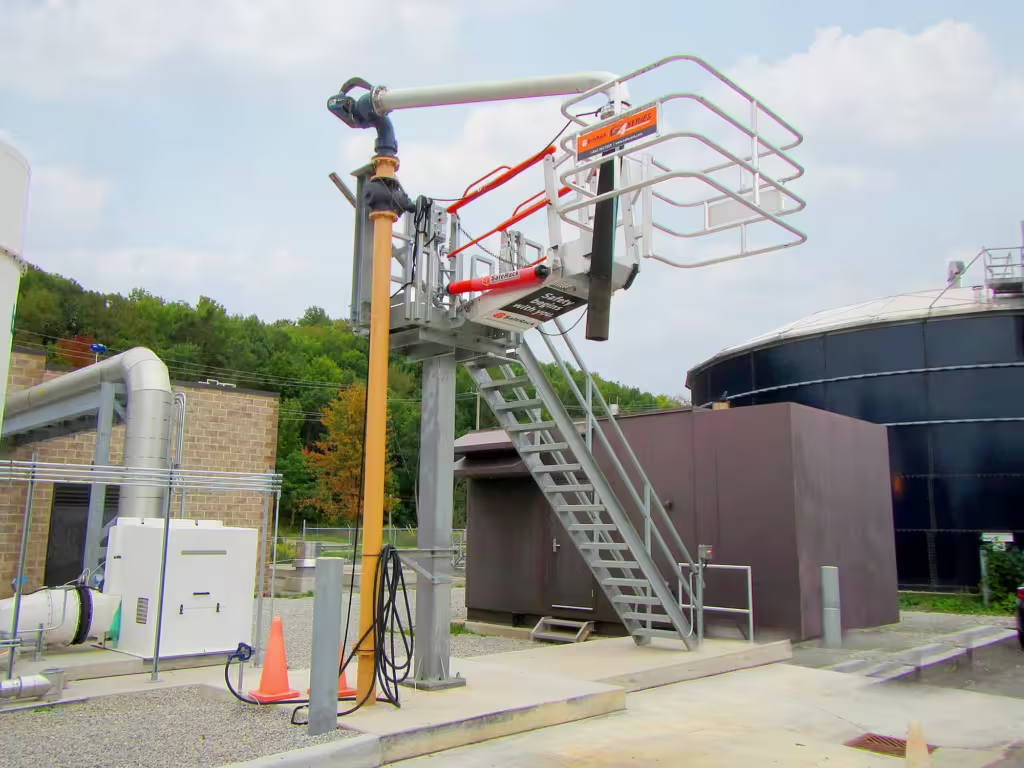
Loading Gangways
A wider access gangway (48″-60″ is preferable) as it helps improve access and egress to and from the vessel. In addition, a wider gangway will reduce the risk of the operator’s PPE getting caught, torn, or damaged, and will improve productivity and safety. Powered gangway solutions are also an option, with both hydraulic and pneumatic solutions being commonly used.
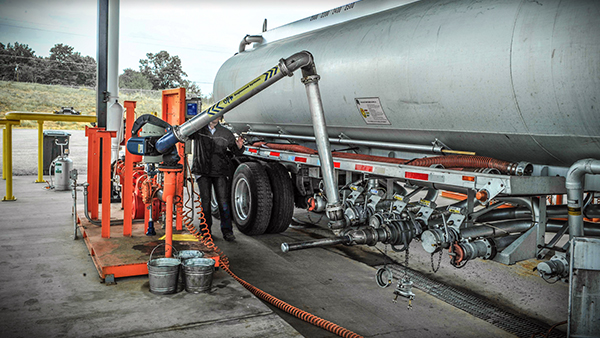
Loading Arms
In paper mills, Tall Oil Fatty Acid (TOFA), Black Liquor, White Liquor, and Green Liquor (Spent Pulping Liquor) are typically loaded into railcars or tank trucks via boom-supported stainless steel loading arms or chemical hoses with a flange connection. The arm or hose will have a top inlet with a control valve to ensure that it is self-draining after use and is supported along the length of a mechanical loading arm to improve handling, known as a by-pass arm. You can install one liquid and one vapor arm, or mount both the liquid and vapor hoses on one by-pass arm.
For unloading, typically you would use a rigid stainless steel self-draining loading arm with Buna-N, PTFE or Viton seals. Purge lines can be fitted to the arm, for nitrogen purging. Additional features such as parking latches with proximity sensors can be incorporated into the total system to ensure the arm is correctly stowed when not in use before any rail movement can occur.
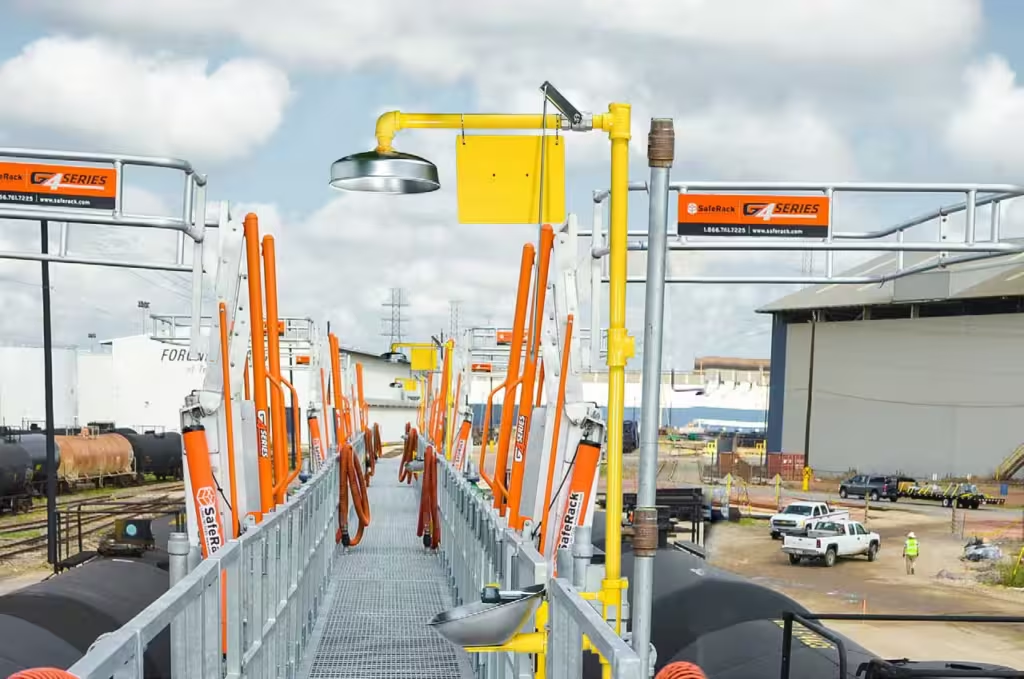
Eye Wash/Drench Showers
Spill containment pans will be provided at the point of loading operations and are an essential piece of equipment in overall site safety and environmental protection
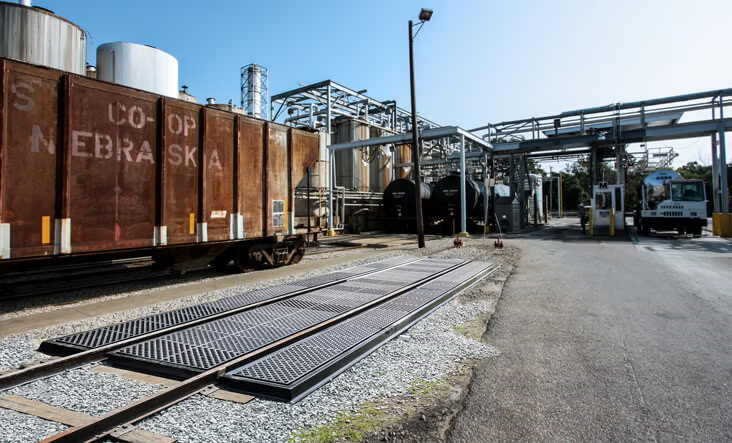
Spill Containment
Spill containment pans will be provided at the point of loading operations and are an essential piece of equipment in overall site safety and environmental protection.
Wheel chocks allow for safe access to and storage of treatment chemicals, while spill containment pans utilized at the point of loading operations serve as essential safety and environmental protection tools.
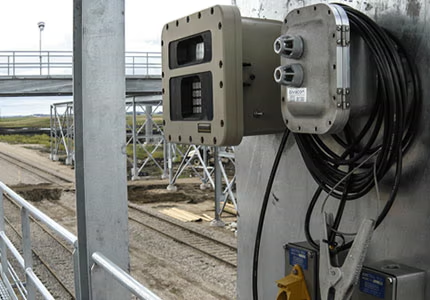
Grounding
While much of the products being transferred in the pulp and paper manufacturing aren’t combustible, it is an industry best practice to include the grounding of all vessels before starting the (un)loading process.
Ground controllers — ensure true grounding before product flow is permitted
Explosion-proof enclosures — meet or exceed UL, CSA, and Ex requirements
Non-sparking tools are also recommended while working around this product
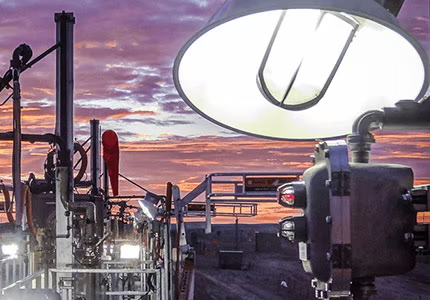
Loading Platform Options
Lighting – General exterior and task lighting to illuminate work and walk areas.
Platform & Canopies – Full platform canopies reduce exposure to the elements and improve the safe and productive loading operation from the operator’s perspective.
Operator Shelter—Depending on your site requirements, consider the requirement of an operator or guard building to keep personnel out of the elements. This can be customized to meet specific site requirements.
Wheel Chocks – SPCC options to allow for safe access and storage of water treatment chemicals.

Safety Gates, Stairs, Ladders, & Platforms
Safety Gates will be installed at the top of stairs and any other openings to ensure operator safety.
SafeRack’s line of industrial safety gates is the most flexible product on the market with the ability to span openings between 16” and 36” and is field adjustable with nothing more than a wrench. We also have guardrails, metal handrails, and full-fledged fall protection solutions with customizable options to fit your needs.
Best Practices for Handling Black Liquor in the Paper & Pulp Industry
Safe handling of black liquor is critical due to its caustic composition and the risk of exposure to harmful gases. Only trained personnel should manage black liquor, ensuring adherence to safety protocols that reduce the risk of injury and environmental harm.
Proper personal protective equipment (PPE) must be worn at all times. This includes chemical-resistant gloves, protective eyewear, and full-body coverings to prevent skin or eye contact. Facilities should be equipped with easily accessible emergency eyewash stations and drench showers in case of accidental exposure.
Ventilation is essential. Black liquor may emit hydrogen sulfide and other sulfur-based gases, particularly when heated or exposed to acids. Strict ventilation controls must be implemented in handling areas to protect against inhalation hazards.
In the event of a spill, immediate containment using absorbent materials and spill containment berms is necessary to protect both personnel and the surrounding environment.
First Aid Measures:
- If exposure occurs, move the affected individual to fresh air right away.
- Remove contaminated clothing and thoroughly wash exposed skin with soap and water.
- For eye exposure, flush eyes with water for at least 15 minutes.
- If black liquor is ingested, do not induce vomiting.
- Contact poison control or seek emergency medical attention immediately.
Critical Safety Warnings:
- Avoid heat, sparks, and open flames. Black liquor can ignite or explode upon contact with combustible materials.
- Avoid contact with acids, which may cause the release of hydrogen sulfide gas—a potentially deadly hazard.
- Do not store or handle black liquor near incompatible substances such as metals or oxidizing agents, which may trigger hazardous reactions.
Adhering to these best practices supports the safe handling of black liquor in pulp mills, reduces risks for workers, and promotes compliance with industry safety standards.
Frequently Asked Questions
Yes, SafeRack’s loading platforms are designed to enhance safety and efficiency in pulp and paper mills. They provide secure access for loading and unloading materials, reducing the risk of falls and improving operational productivity.
SafeRack’s gangways offer safe passage over hazardous areas such as chippers and conveyors, minimizing the risk of accidents. Their durable construction ensures long-term reliability in demanding mill environments.
Absolutely, SafeRack provides spill containment systems specifically designed to manage hazardous chemicals commonly used in pulp and paper production, ensuring environmental compliance and workplace safety.
SafeRack offers custom specialty platforms that help improve worker safety, ergonomics, and productivity when accessing elevated equipment in pulp and paper mills.
Yes, SafeRack’s safety solutions are designed to meet or exceed OSHA regulations, ensuring that pulp and paper facilities maintain compliance while protecting their workforce.
Projects
-
Static Electricity Safety
Static Electricity in Hazardous Locations: Your Complete Guide to Prevention and Protection Static electricity poses a significant ignition risk in…
-
Harness-Free Loading: A Safer Standard
SafeRack gangways effectively eliminate the need for fall protection harnesses in truck and railcar loading operations, helping operators like those…



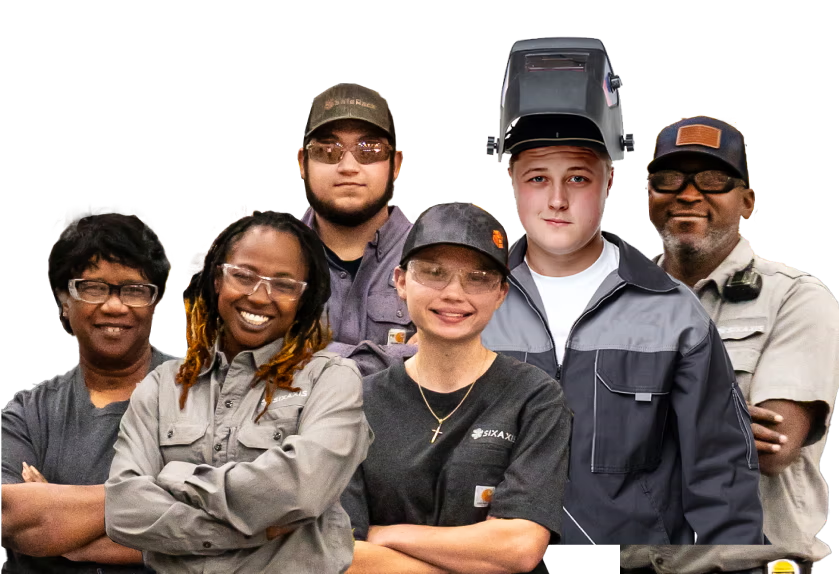

 Download
Download

